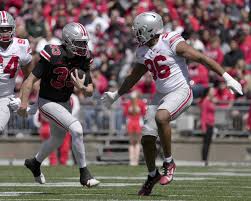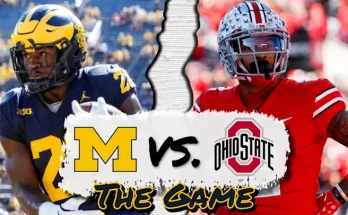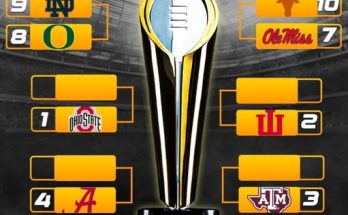The End of an Era: Game Simulation Likely to be Lost in Ohio State’s Traditional Spring Scrimmage Format
For decades, the spring scrimmage at Ohio State University has been a cherished tradition in the world of college football. It has been a rite of passage for both the players and fans alike—a unique blend of football intensity and exhibition, a chance for the fans to catch their first glimpse of the upcoming season. However, as the game simulation increasingly fades in importance, many are beginning to wonder if Ohio State’s traditional spring scrimmage format will ever be the same again.
The spring scrimmage has long served as a springboard for Ohio State’s football team, where players get the opportunity to show off their skills, showcase their athleticism, and earn coveted positions on the roster. It has also provided a prime platform for fans to become familiar with new recruits, watch returning stars develop further, and get excited about the upcoming season. However, in the face of changes within the sport and shifts in football philosophy, this cherished event may be on the brink of transformation, potentially signaling the end of a decades-old tradition.
The Traditional Spring Scrimmage
Before diving into the specific reasons behind the decline of game simulation during Ohio State’s spring football event, it is important to understand the significance of the spring scrimmage in its classic form. Typically, the Ohio State spring game was a full-scale, competitive football game—albeit with some modifications. Teams were divided by different criteria, sometimes with players assigned to different rosters based on positions, seniority, or even arbitrary groupings. The purpose of the event was not only to provide exposure to potential recruits but also to simulate the real-game experience as much as possible.
While it was technically a scrimmage, the atmosphere closely resembled that of a regular game. Fans filled Ohio Stadium, and the players competed with intensity. The event allowed for tangible evaluations, such as assessing the progression of young players, the health of returning veterans, and the overall cohesion of the team’s units. Coaches also used the spring scrimmage to make decisions about depth charts, and the event even had implications on recruitment and retention.
However, as the years have passed, changes in football culture, recruiting dynamics, and scheduling practices have chipped away at the traditional format. The “game simulation” aspect of Ohio State’s spring football experience is likely to be the most significant casualty of these shifts.
Shift in Football Philosophy
The crux of the issue lies in the changing approach to spring football in general. The introduction of the NCAA’s newer rule changes—especially regarding redshirt eligibility and the increasing number of bowl games—has altered the way teams approach their off-season training and development.
Ohio State, like many elite football programs, is now placing more emphasis on player safety and the long-term health of athletes. The football staff and coaches understand that it is crucial to limit unnecessary injuries, particularly for players who may have long-term careers ahead of them. Consequently, limiting the wear and tear of competitive spring games has become a more significant priority. Ohio State’s coaching staff, headed by Ryan Day, recognizes that limiting the exposure of key players to full-contact situations, where injuries are most likely to occur, helps ensure the team’s health and preparedness as the season progresses.
In this regard, the scrimmage format has slowly been modified over time to avoid high-contact play. This gradual transformation reflects a growing concern over the increased rates of injuries in college football, including concussions, torn ligaments, and other high-impact collisions. The reduction of full-game scenarios during spring drills allows players to build up to a competitive level without risking career-threatening injuries.
Another factor contributing to this shift in philosophy is the changing approach to player development. Coaches are now placing less emphasis on scrimmages as a testing ground for depth-chart battles and instead using a more analytical approach. The evolution of sports analytics, combined with enhanced video technology, has allowed coaching staffs to evaluate player performance without the need for traditional scrimmage environments. Advanced stats and film breakdowns provide in-depth insight into player development, allowing the coaching staff to make decisions based on detailed data rather than subjective observation during a controlled game simulation.
As a result, the traditional format of game simulations during spring football has given way to more controlled, organized drills and practice sessions. This change doesn’t mean that the coaching staff is any less committed to evaluating talent or fine-tuning strategies; rather, it reflects the evolution of football toward data-driven decisions.
Redshirt Rule and the Impact of Player Development
One of the biggest game-changers in the sport in recent years is the introduction of the new redshirt rule, which allows players to participate in up to four games during a season without burning their eligibility. This change has fundamentally shifted the dynamics of team-building and player development. Coaches are now tasked with making decisions based on a longer-term perspective, ensuring that they don’t push players into high-stakes situations too soon.
This redshirt rule directly impacts the traditional spring scrimmage, which was once a prime opportunity for players to prove their worth and secure playing time for the upcoming season. Now, coaches are more inclined to evaluate players through a more extended and nuanced process, rather than relying solely on the results of a single exhibition-style game. The emphasis has shifted toward ensuring players have ample time to develop in practice, absorbing the playbook, refining their techniques, and gaining experience in non-competitive scenarios.
In light of these changes, the spring game no longer serves as a pivotal testing ground for players on the roster. The incentive to place players in high-contact situations for a game that doesn’t count toward the regular season feels unnecessary when coaches can achieve the same results through more targeted development techniques.
Recruiting and Its Impact on Scrimmage Format
Recruiting has also undergone a significant shift in recent years, and this has contributed to the loss of the game simulation element in Ohio State’s spring scrimmage. With recruiting now beginning earlier in high school and the ever-growing role of social media in promoting players, coaches are relying more heavily on film and scouting reports than ever before. Additionally, the National Letter of Intent (NLI) process, which locks in players early, has made spring scrimmages less vital as recruiting tools.
Coaches are less focused on impressing recruits by showcasing the team’s talent in a public game setting, since most of Ohio State’s targets have already been scouted and evaluated well before the spring game. With recruits often deciding on their college commitment years before their senior seasons, the impact of a single spring scrimmage in the eyes of a recruit has diminished.
Furthermore, many college programs are actively recruiting players to participate in spring football as early enrollees, who then have the opportunity to experience spring practice. These players, generally not expected to contribute immediately, are given a head start in terms of developing their skills within the program’s system. Coaches are no longer relying on a single game for recruitment, instead trusting in year-round evaluation techniques that are more comprehensive.
The Evolution of Fan Engagement
For Ohio State fans, the spring game was once a great way to see the future stars of the team in action, especially for recruits or redshirt freshmen who hadn’t seen the field much during the regular season. However, with the changing landscape of college football, fan engagement has taken on a different tone.
Fans still pack into Ohio Stadium each year, eager to see their Buckeyes in action. However, the expectations surrounding the spring scrimmage have shifted. The hype and excitement surrounding the event are still there, but as coaches have leaned more into the practice-style evaluation and development approach, the event itself has become less about football competition and more about entertainment and a showcase for fans to enjoy the team in an informal setting.
Some teams, including Ohio State, have adjusted their spring format to include fan-friendly elements like special guest appearances, skill competitions, and other interactive experiences. These additions focus more on entertaining the fans than creating a hyper-competitive, game-like atmosphere. As a result, the traditional “game simulation” is now secondary to the overall fan experience, and the game itself has become more of a celebration than a true evaluation of football talent.
The Future of Ohio State’s Spring Scrimmage
While the shift away from game simulation in Ohio State’s spring scrimmage may seem like the loss of an important tradition, it is ultimately a reflection of how college football continues to evolve. The game simulation, once the pinnacle of spring football, is likely to fade into the background as the emphasis on player safety, analytics, and recruitment changes the nature of off-season training.
However, this doesn’t necessarily spell doom for the tradition. While the format may no longer include the full-contact, game-like experience, Ohio State’s spring scrimmage will still be an event to remember. It may just look different in the future—perhaps more focused on player development, fan engagement, and entertainment.
In the end, while the loss of game simulation may mark the end of an era, it also signals the beginning of a new chapter in Ohio State’s spring football tradition. Whether fans are there for the game, the spectacle, or to witness the next generation of football stars, one thing is clear: Ohio State’s commitment to excellence will continue to shine, regardless of how the spring scrimmage evolves.
The future of Ohio State’s spring football may look different, but its passion for football and its rich tradition will undoubtedly remain at the forefront of the team’s mission to succeed both on and off the field.



